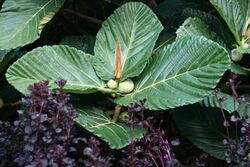Biology:Ficus dammaropsis
| Ficus dammaropsis | |
|---|---|

| |
| Ficus dammaropsis showing large leaves and syconia (fruit of figs) | |
| Scientific classification | |
| Kingdom: | Plantae |
| Clade: | Tracheophytes |
| Clade: | Angiosperms |
| Clade: | Eudicots |
| Clade: | Rosids |
| Order: | Rosales |
| Family: | Moraceae |
| Genus: | Ficus |
| Subgenus: | F. subg. Sycomorus |
| Species: | F. dammaropsis
|
| Binomial name | |
| Ficus dammaropsis Diels
| |
| Synonyms | |
|
Dammaropsis kingiana | |
Ficus dammaropsis, called kapiak in Tok Pisin, is a tropical fig tree with huge pleated leaves 60 cm (24 in) across and up to 90 cm (3 feet) in length.[1] on petioles as much as thirteen inches (32 centimeters) long and one inch (2.5 cm) thick. These emerge from a stipular sheath up to fourteen inches ( 38 cm) long, the largest of any Dicot. It is native to the highlands and highlands fringe of New Guinea. It generally grows at altitudes of between 850 and 2,750 metres (2,790 and 9,020 ft). Its fruit, the world's largest figs (syconia), up to six inches (15 centimeters) in diameter, are edible but rarely eaten except as an emergency food. They are pollinated by the tiny wasp Ceratosolon abnormis.[2] The young leaves are pickled or cooked and eaten as a vegetable with pig meat by highlanders.[3]
The lowland form of this species found commonly below 900 meters is recognized as a distinct species, Ficus brusii.
The species can be found at the Melbourne Botanic Gardens, located in the ‘Yucca Bed’.[4]
Cultivation
With its bold tropical leaves and relative tolerance of cold, F. dammaropsis is cultivated as an ornamental tree in frost-free climates.
References
- ↑ anonymous (2005). "Moraceae - Ficus". Flora Malesiana 17 Part 2: 378.
- ↑ anonymous (August 20, 2021). "NParks - Ficus dammaropsis". https://www.nparks.gov.sg/florafaunaweb/flora/7/2/7261.
- ↑ Ezedin, Z.; Weiblen, G.D. (2019-09-27). "Additions and changes to Ficus (Moraceae) in New Guinea with comments on the world's largest fig". Gardens' Bulletin Singapore 71 (suppl.2): 197–216. doi:10.26492/gbs71(suppl.2).2019-15. ISSN 0374-7859.
- ↑ "RBG Census". https://data.rbg.vic.gov.au/rbgcensus/census/plant/1315050d-274c-4d8b-80ed-76eef30d6be1.
- R. Michael Bourke (nd). "Indigenous fruit in Papua New Guinea". Research School of Pacific and Asian Studies. The Australian National University. Archived from the original on 2007-07-31. https://web.archive.org/web/20070731172054/http://www.icuc-iwmi.org/files/Publications/Bourke%20-%20Indigenous%20fruit%20in%20PNG.pdf. Retrieved 2008-06-19.
- R.N. Kambuou (1996). "Papua New Guinea: Country Report". FAO International Technical Conference on Plant Genetic Resources, (Leipzig,1996). Food and Agriculture Organization of the United Nations. http://www.fao.org/ag/AGP/agps/pgrfa/pdf/papuanew.pdf. Retrieved 2008-06-19.
Wikidata ☰ Q5446605 entry
 |




